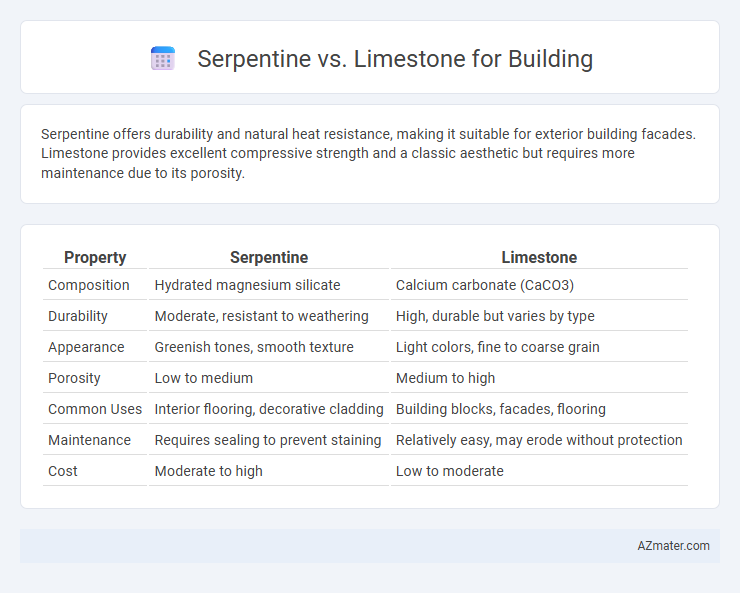Serpentine offers durability and natural heat resistance, making it suitable for exterior building facades. Limestone provides excellent compressive strength and a classic aesthetic but requires more maintenance due to its porosity.
Table of Comparison
| Property | Serpentine | Limestone |
|---|---|---|
| Composition | Hydrated magnesium silicate | Calcium carbonate (CaCO3) |
| Durability | Moderate, resistant to weathering | High, durable but varies by type |
| Appearance | Greenish tones, smooth texture | Light colors, fine to coarse grain |
| Porosity | Low to medium | Medium to high |
| Common Uses | Interior flooring, decorative cladding | Building blocks, facades, flooring |
| Maintenance | Requires sealing to prevent staining | Relatively easy, may erode without protection |
| Cost | Moderate to high | Low to moderate |
Introduction to Serpentine and Limestone
Serpentine and limestone are both widely used natural stones in the construction industry, each possessing unique geological characteristics and aesthetic qualities. Serpentine is a metamorphic rock known for its rich green hues and smooth texture, formed through the alteration of ultramafic rocks rich in magnesium and iron. Limestone, a sedimentary rock composed primarily of calcite, features a range of colors from white to beige and offers high durability and versatility for building facades and interior applications.
Geological Formation and Composition
Serpentine forms primarily through the metamorphic alteration of ultramafic rocks rich in magnesium and iron, characterized by its greenish, often fibrous structure composed mainly of serpentine group minerals such as lizardite, antigorite, and chrysotile. Limestone is a sedimentary rock predominantly composed of calcite (calcium carbonate), originating from the accumulation of marine organism shells and skeletal fragments, resulting in a primarily biogenic and chemical precipitation process. The mineralogical differences between serpentine's silicate structure and limestone's carbonate composition influence their durability, porosity, and suitability for various architectural applications.
Key Physical Properties
Serpentine exhibits a medium hardness of 3 to 6 on the Mohs scale and features a distinctive greenish hue with a smooth, sometimes fibrous texture, providing moderate durability and resistance to weathering. Limestone, primarily composed of calcite with a hardness of 3, offers uniform grain and high workability but is more susceptible to acid rain and erosion due to its calcite content. Key physical properties influencing their use include serpentine's superior tensile strength and resistance to chemical breakdown, making it suitable for decorative cladding, while limestone's porosity and ease of carving favor its application in detailed architectural elements and structural blocks.
Durability and Weather Resistance
Serpentine offers moderate durability and weather resistance but is prone to weathering due to its softer mineral composition and susceptibility to acidic rain. Limestone, characterized by higher density and strength, provides superior durability and resists weathering better, making it ideal for exterior construction in variable climates. Both materials require maintenance, yet limestone's lower porosity significantly enhances its longevity against moisture and freeze-thaw cycles.
Aesthetic and Color Variations
Serpentine offers rich green, mottled patterns that add a unique, natural elegance to architectural facades, while limestone presents a broad palette from creamy whites to warm beiges, enhancing classic and timeless aesthetics. The textural contrast of serpentine's glossy finish versus limestone's matte surface influences light reflection and visual depth in building designs. Both stones provide versatile color variations that cater to different stylistic preferences, with serpentine serving well for bold, statement pieces and limestone suited for subtle, refined exteriors.
Workability and Construction Uses
Serpentine offers moderate workability due to its relatively soft texture, making it suitable for decorative elements and interior cladding in construction. Limestone's excellent workability allows for precise cutting and shaping, which is ideal for structural components, facades, and detailed architectural features. Both materials serve distinct construction uses, with serpentine favored for aesthetic appeal and limestone preferred for its strength and versatility in building projects.
Environmental Impact and Sustainability
Serpentine and limestone vary significantly in environmental impact and sustainability when used in building construction. Serpentine, often containing chrysotile asbestos, poses health risks during extraction and processing, raising environmental and safety concerns. Limestone extraction typically results in habitat disruption and CO2 emissions from quarrying and calcination, but its natural abundance and recyclability offer more sustainable lifecycle options compared to serpentine.
Cost Comparison and Availability
Serpentine generally costs more than limestone due to its limited availability and complex quarrying process. Limestone is widely available, making it a more budget-friendly option for construction projects with consistent pricing across regions. The cost-effectiveness of limestone combined with its abundant supply often makes it the preferred choice over serpentine in large-scale building applications.
Common Applications in Building
Serpentine is commonly used for decorative elements such as tiles, facades, and interior wall cladding due to its attractive green hues and ease of polishing. Limestone is widely applied in structural components like load-bearing walls, flooring, and exterior facades because of its durability and workability. Both materials are favored for their natural beauty, but limestone's strength makes it a preferred choice for foundational and exterior uses in construction.
Choosing the Right Stone for Your Project
Serpentine offers excellent durability and natural resistance to weathering, making it suitable for exterior building applications, while limestone provides timeless aesthetic appeal and ease of carving for intricate architectural details. When choosing the right stone for your project, consider serpentine's greenish hues and dense texture for a modern or rustic look, versus limestone's softer, lighter tones that enhance traditional designs. Evaluate factors such as climate, structural requirements, and desired finish to ensure the selected stone aligns with both functional and design goals.

Infographic: Serpentine vs Limestone for Building
 azmater.com
azmater.com